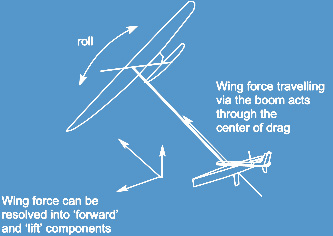

What about a craft in which all driving and drag forces act through a single point? Surely it would be stable at any speed. Hands-off high speed sailing?
Furthermore, if some way could be found to make water drag actually reduce with speed such a craft would have to go quite fast ....
Engineer Bill Rayner in Sydney Australia posed these questions and addressed these design challenges in 1997.
The name came easily - surely 'Dingbat' would describe both the craft and the crazies prepared to challenge yachting's conventions.
Features of Dingbat Technology
1 30% double surface wing designed on advanced hang glider technology. An adjustable tailplane controls lift ie power.
2 The wing force roughly follows the carbon fibre 'boom' to the centre of the keel reaction force. The horizontal component of the wing force induces speed. The vertical component lifts the hull. This reduces the wetted area and hence the drag. At top speed all driving and drag forces are in balance and only the fin is in the water.
3 The 'Pilot' seated at one end of a beam balances the weight of the wing. A rotating turret enables variation of the bearing.
4 Controls. The wing and rudder are controlled by a joystick.




What is Dingbat like to sail?
Dingbat works like a kitesurfer but with more efficiency, control and comfort.
When you are piloting Dingbat you are seated at all times!
The breeze causes the wing to provide lift and forward propulsion. Gusts increase your speed WITHOUT attempting to tip you over. It is uncanny.
A joy stick enables you to control the angle of attack of the wing and hence the power it generates.
The rotating turret enables you to change your bearing. Tacking and gybing are fast and fluent.